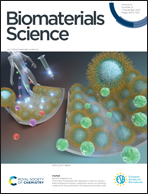Skin adhesion to the percutaneous component of direct bone anchored systems: systematic review on preclinical approaches and biomaterials†
Abstract
Nowadays, direct bone anchored systems are an increasingly adopted approach in the therapeutic landscape for amputee patients. However, the percutaneous nature of these devices poses a major challenge to obtain a stable and lasting proper adhesion between the implant surface and the skin. A systematic review was carried out in three databases (PubMed, Scopus, Web of Science) to provide an overview of the innovative strategies tested with preclinical models (in vitro and in vivo) in the last ten years to improve the skin adhesion of direct bone anchored systems. Fifty five articles were selected after screening, also employing PECO question and inclusion criteria. A modified Cochrane RoB 2.0 tool for the in vitro studies and the SYRCLE tool for in in vivo studies were used to assess the risk of bias. The evidence collected suggests that the implementation of porous percutaneous structures could be one of the most favorable approach to improve proper skin adhesion, especially in association with bioactive coatings, as hydroxyapatite, and exploiting the field of nanostructure. Some issues still remain open as (a) the identification and characterization of the best material/coating association able to limit the shear stresses at the interface and (b) the role of keratinocyte turnover on the skin/biomaterial adhesion and integration processes.



 Please wait while we load your content...
Please wait while we load your content...